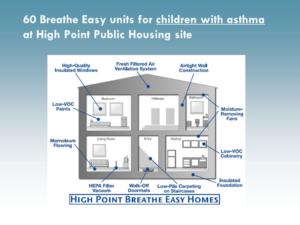Breathing Easier in Healthier Buildings
Most people know asthma is a condition that makes it difficult to breathe; what most people do not know, however, is that asthma can have lasting impacts on quality of life. It affects education, finances, occupation, physical fitness, and even vacation choices.
With an average $3,300 in medical expenses per person a year, asthma is a costly condition that often leads to missed days of school or work, hindering education and advancement. In 2013, children ages 5 to 17 missed 13.8 million days of school—with an average of 2.6 days of school missed per child—and 33 percent of adults missed a day of work due to an asthma attack.
Moreover, asthma disproportionately affects low-income residents and communities of color. According to the CDC report on Asthma in Children, asthma was 10.5 percent more prevalent in children living in low-income families than in those in families living above the poverty level. Communities of color suffer disproportionately as well, with black children suffering at a rate (15.7 percent) that is double that of their Latino (6.7 percent) and white (7.1 percent) counterparts. However, when it comes to asthma attacks, Latino children are 60 times more likely to have an asthma attack than white children.
Asthma is a public health issue and treatment often focuses on management of the disease through medical intervention and education post-diagnosis. These treatment methods are important and necessary but it is just as crucial to address the root causes of asthma and remove exposure to triggers, refocusing the conversation on asthma prevention as opposed to management.
On average, Americans spend 90 percent of their time indoors; we live our lives going from one indoor space to the next. But being indoors can mean greater exposure to many asthma triggers, including a number of chemicals known to play a role in the development and exacerbation of asthma.
Indoor triggers of asthma include:
- Chemicals found in building products, including flooring, insulation, carpets, and paints;
- Second-hand smoke;
- Scented products, including candles, perfumes, and cleaning products;
- Pet dander;
- Pests; and
- Dust and other build up, which often accumulates in carpets.
A 2011 study—which explored whether low-income housing renovations using healthy principles improve health—found that residents saw significant health cost reductions and suffered less from avoidable illnesses The percentage of children with respiratory problems such as hay fever, bronchitis, and allergies dropped from 33 percent to 15 percent in the renovated homes. The renovations included the use of healthier building materials with low off-gassing, a key feature of healthier homes.
A similar study done in Seattle examined health impacts when asthmatic children move out of older housing stock into homes that focus on eliminating asthma triggers. Children living in the new Breathe Easy Homes, had 63 percent more symptom-free days and saw a 66 percent reduction in need for urgent medical care.
Incorporating healthier building materials into building standards and encouraging owners, contractors, designers, and architects to specify the use of healthier building products could drastically improve the quality of life for millions of Americans living with and suffering from respiratory problems.
